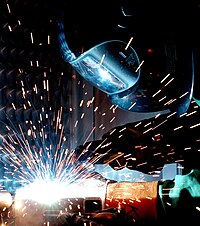
Photo from wikipedia
This paper investigated the effect of repair welding on the microstructure, mechanical properties, and high cycle fatigue properties of S355J2 steel T-joints in orthotropic bridge decks. The test results found… Click to show full abstract
This paper investigated the effect of repair welding on the microstructure, mechanical properties, and high cycle fatigue properties of S355J2 steel T-joints in orthotropic bridge decks. The test results found that the increase in grain size of the coarse, heat-affected zone decreased the hardness of the welded joint by about 30 HV. The tensile strength of the repair-welded joints was reduced by 20 MPa compared to the welded joints. For the high cycle fatigue behavior, the fatigue life of repair-welded joints is lower than that of the welded joints under the same dynamic load. The fracture positions of toe repair-welded joints were all at the weld root, while the fracture positions of the deck repair-welded joints were at the weld toe and weld root, with the same proportion. The fatigue life of toe repair-welded joints is reduced more than that of deck repair-welded joints. The traction structural stress method was used to analyze fatigue data of the welded and repair-welded joints, and the influence of angular misalignment on was considered. The fatigue data with and without AM are all within the ±95% confidence interval of the master S-N curve.
Journal Title: Materials
Year Published: 2023
Link to full text (if available)
Share on Social Media: Sign Up to like & get
recommendations!